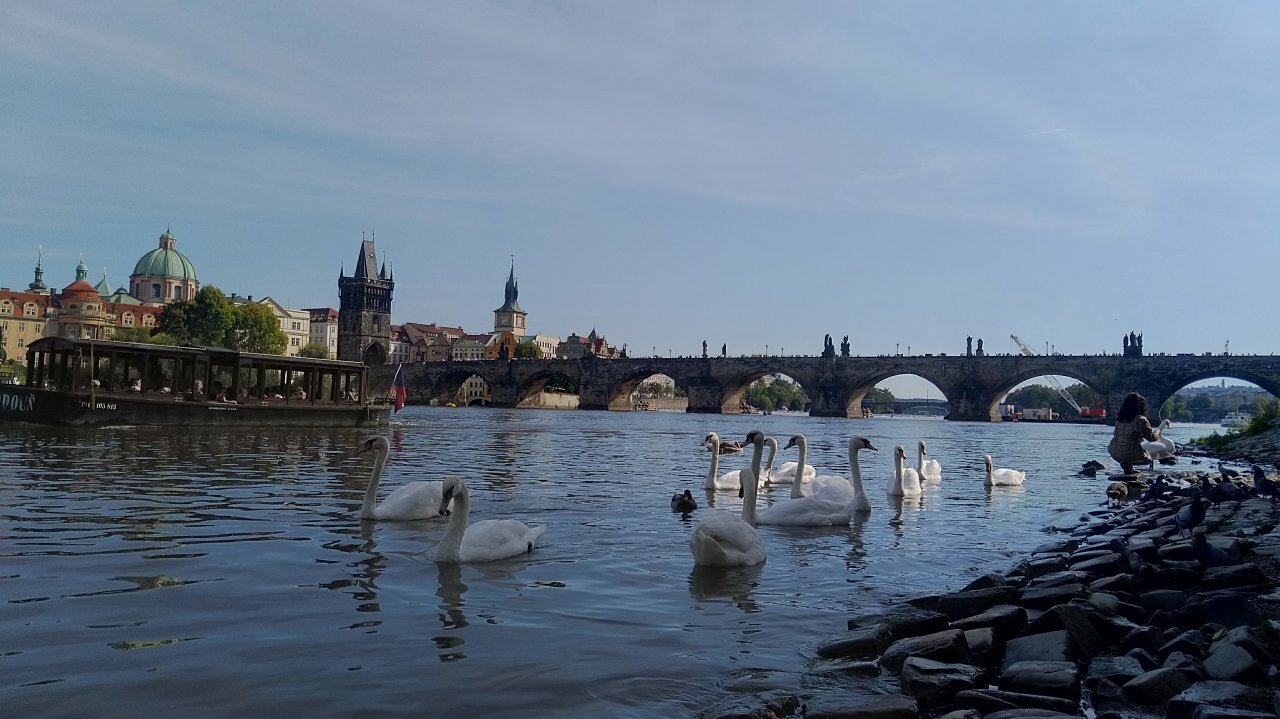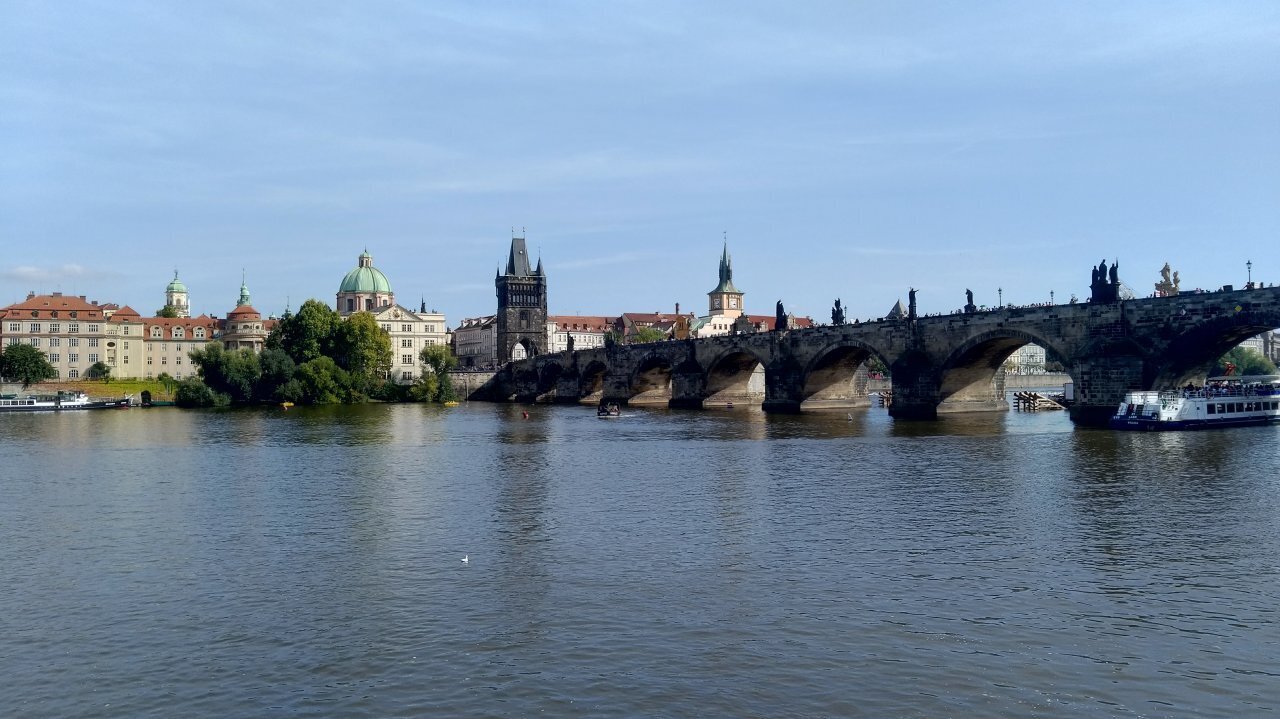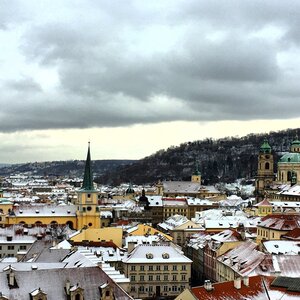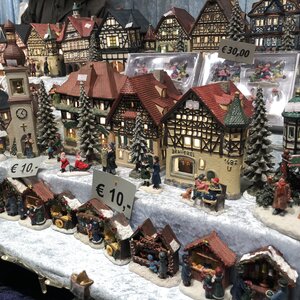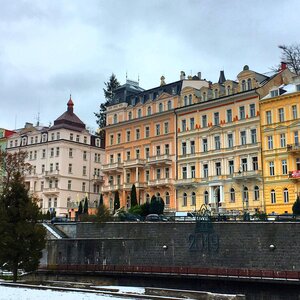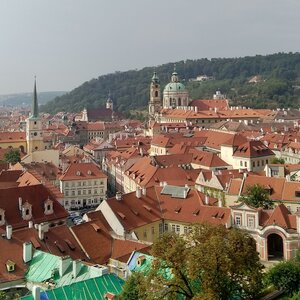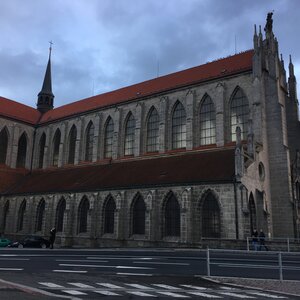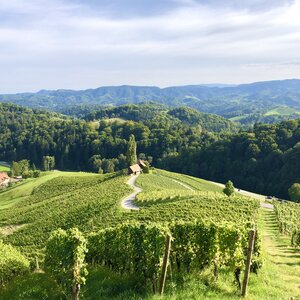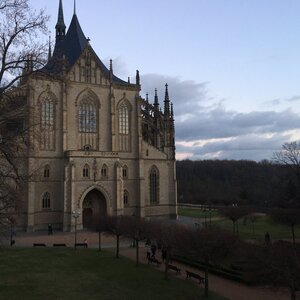Characteristics
- Length: 516 meters.
- Width: 9.5 meters.
- Height: 13 meters.
- Number of statues: 32.
History
The bridge as we see it today was built in 1348. Before that, the two banks of the river were connected by the Judith Bridge, the only crossing of the Vltava. Trade in Prague was growing rapidly, the old structure seemed unreliable, and in 1342 it failed to survive a flood.
The new stone bridge was built on the orders of Charles IV. The years of his reign were the «Golden Age» for Prague, and Prague flourished under his rule. Nové Město, Hradcany, the first university — and a new bridge.
Charles wanted the structure to stand the test of time. The construction was entrusted to the architect Petr Parlerž — he completed the St. Vitus Cathedral and after the Charles Bridge he designed the All Saints' Cathedral.
The first stone of the bridge was laid in 1357 on July 9, at 5:31. The date is a sequence of numbers derived by Prague astronomers — 135797531. The king believed in the magic of numbers and that the bridge would be eternal.
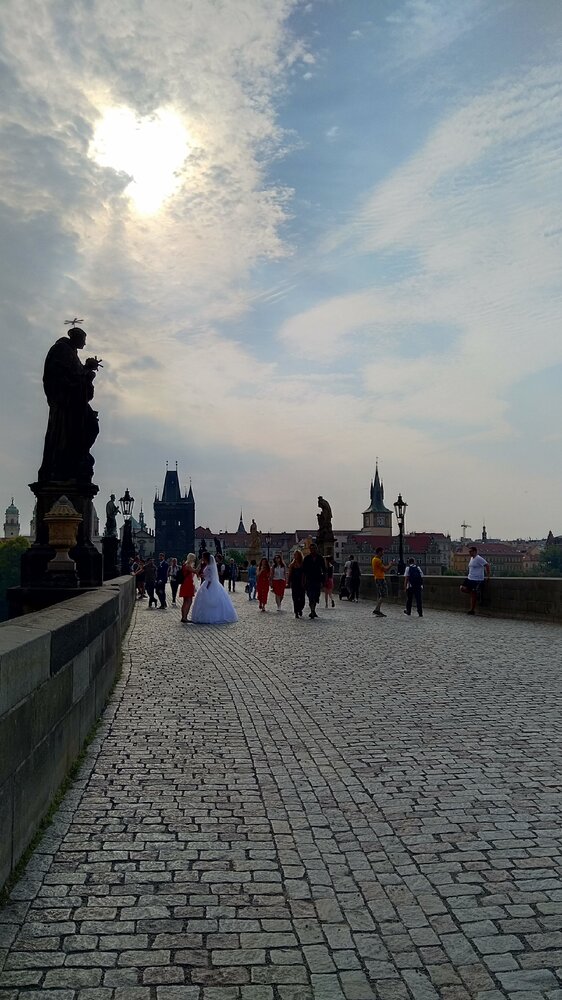
The project was ambitious — the main Prague bridge was built for 50 years. The structure was sturdy and spacious, so it became a place for important events. The Royal Route passed over the bridge — a ceremonial route for future Czech rulers who went to St. Vitus Cathedral for their coronation. On holidays, fairs and shows were held here, and criminals were executed.
During the Thirty Years' War, the Swedes tried to break through to the right bank across the bridge, but could get no farther than the statue of Christ.
Legends of Charles Bridge
Legends are much more interesting than moments in history. For example, it is said that the structure was made strong by a mortar containing eggs, wine and milk.
Adding eggs to lime and clay is the norm. But scientists have also found cottage cheese, sugar, beer and ox blood in the composition. Maybe that’s why the Charles Bridge hasn’t needed serious repairs for a long time — almost seven centuries.
Prague didn’t have enough eggs, so they had to bring them from all over the country. But the inhabitants of Velvary did not understand why fresh eggs were needed and were worried that they would go rotten on the way, so they boiled them in advance. The boiled eggs were not used in the construction.

According to another version, the bridge is reliable because of the architect’s deal with the devil. According to the agreement, the devil was entitled to the soul of the first person to walk on the bridge. The architect was more cunning: a rooster was the first to go for a walk.
Here are a few more legends:
- there’s a talented devil who walks across the bridge and gives everyone his portraits;
- Under one of the arches lives the watery Josef, who likes to smoke and chat with passers-by, and also collect the souls of drowned people in pots;
- The figures of five kingfishers are hidden on the Old Town Tower, and if you find them all, everything will turn out well in life.
Some say they heard a sneezing boy whose soul was carried away by the devil. Some have met saints. Who knows what fantasies the brain is capable of after a couple of beers.
Charles Bridge Sculptures
There are 32 Baroque statues on the railing of the Charles Bridge — they form an open-air gallery.
At that time, statues were a political necessity, not just decoration. In 1526 — 1740 Czech lands were under the rule of Austrian Habsburgs — they restored the Catholic Archbishopric of Prague, and the Catholic Church supported their power. First they destroyed the tomb of Jan Hus, the leader of the rebellion against the church (Hussite Wars), and then they started to put statues on the bridge to remind people how much faith had influenced the prosperity of the country.
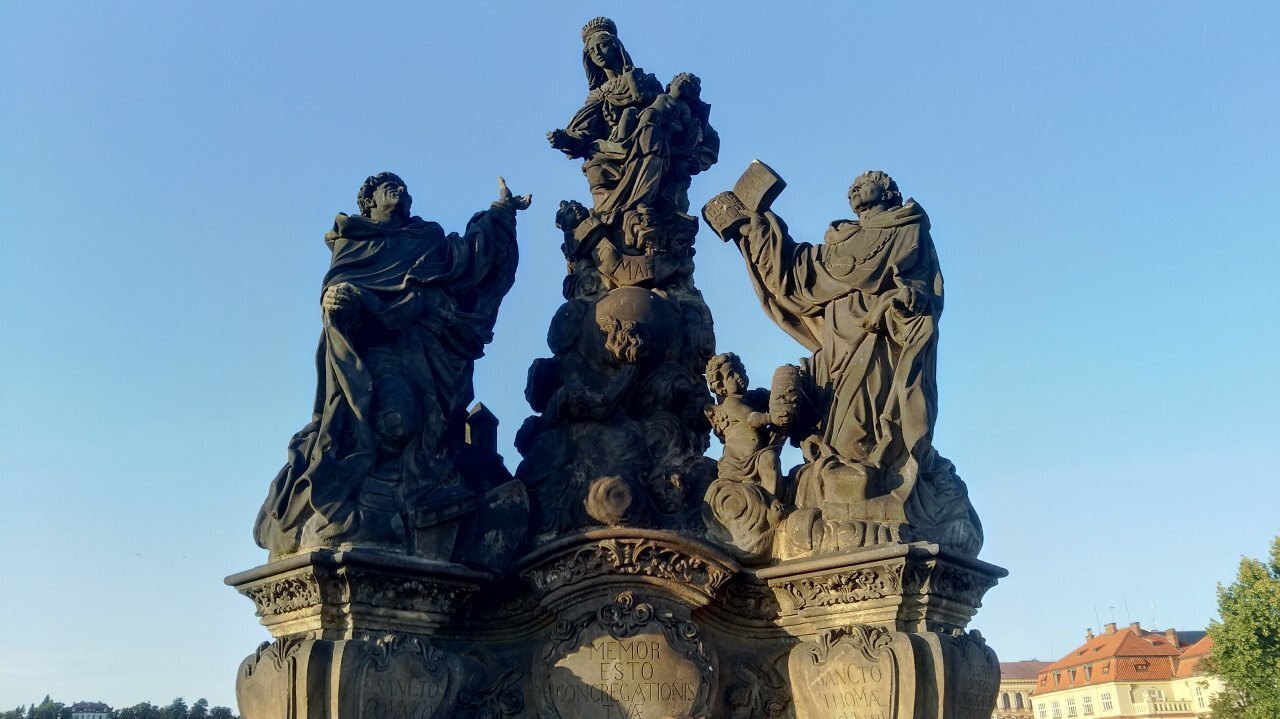
The statues were created in the XVII–XVIII centuries by different creators. They are made of sandstone, which is not the most durable stone. Weather, time and vandalism have worn away the material.
There are few original sculptures on the bridge. They are the Crucifixion of Christ, the figure of Jan Nepomucký, Philip Benizia and a few others, and the rest are copies. The worn and sunken statues were moved to the Vyšehrad Kazemats and the Lapidarium of the National Museum.
Usually sightseeing tours start from Stare Mesto, and then guides lead tourists across the bridge to the right bank. Along the same route I took photos of the statues, one by one: from the right and one from the left. Now I will tell you about them in order. These are figures of saints, patrons and kings associated with the history of the Christian faith.
Madonna with St. Bernard
A statue of the Madonna with a cross in her right hand and a child in her left, right — St. Bernard of Clairvaux. As an abbot, he created a large and influential Cistercian order.
Abbot Bernard was eloquent. He persuaded Pope Eugene III to launch a crusade eastward toward pagan Europe under the slogan «baptism or death».
To the left of the Madonna is the face of Jesus and angels with the trappings of his death: the shroud, cross, nails and hammer.
- Author: Matej Václav Jekel.
- Year: 1709.
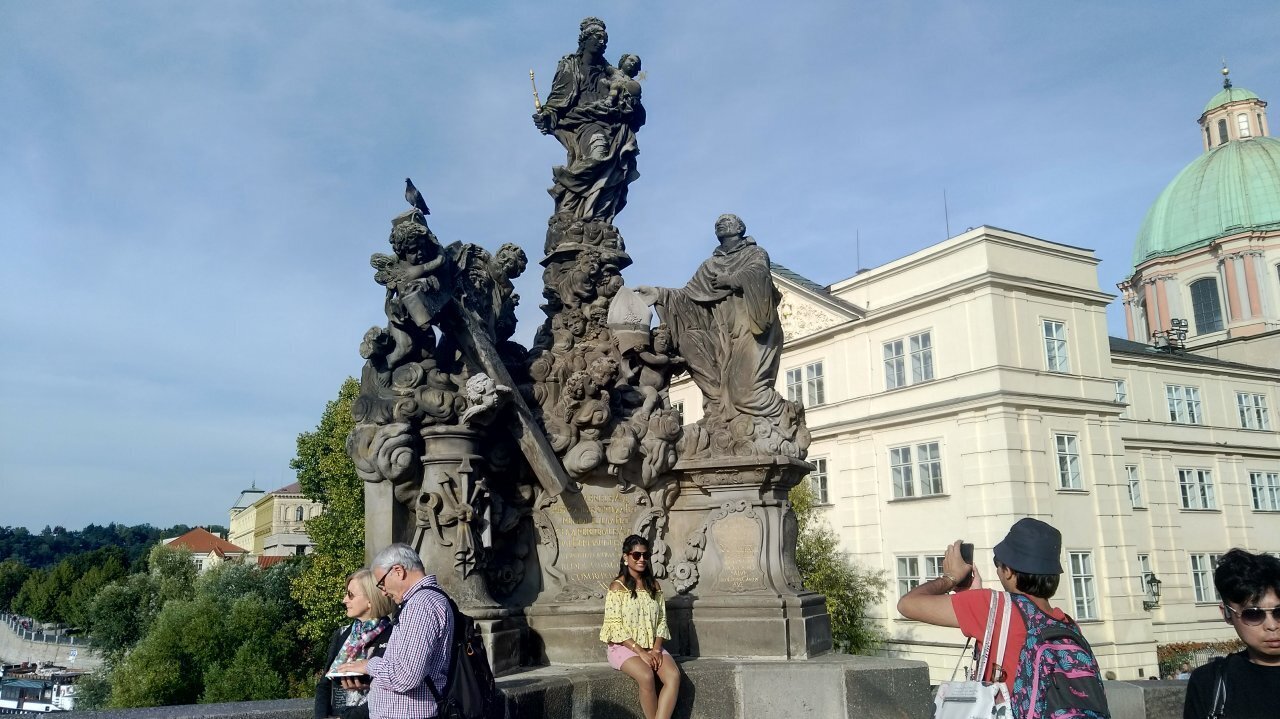
St. Ivo
The patron saint of lawyers, Ivo of Breton was an ecclesiastical judge and patronized the common people. He protected, helped build orphanages, orphanages and hospitals for the poor. For this he was loved and honored in his native France.
The author depicted St. Ivo helping a mother and son resolve a dispute.
- Author: Matthias Braun.
- Year: 1711.
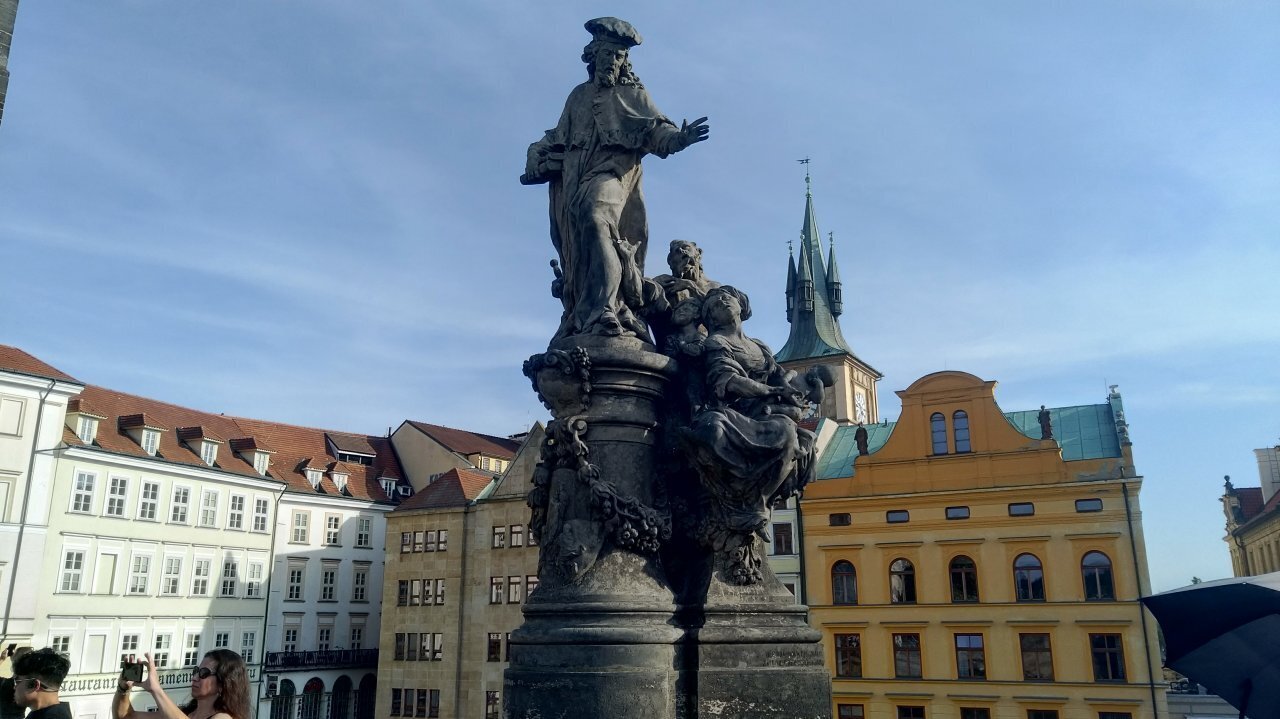
Madonna with St. Dominic and St. Thomas Aquinas
Note where the Madonna is standing — on a globe. This composition reminds us of the vast spread of the Christian religion.
Madonna gives rosary beads to St. Dominic — creator of the rosary — praying the rosary. St. Thomas Aquinas holds an open book, unfolding it for the Madonna. This book is the Summa Theologica, and he is its author.
- Author: Matej Václav Eckel.
- Year: 1708.
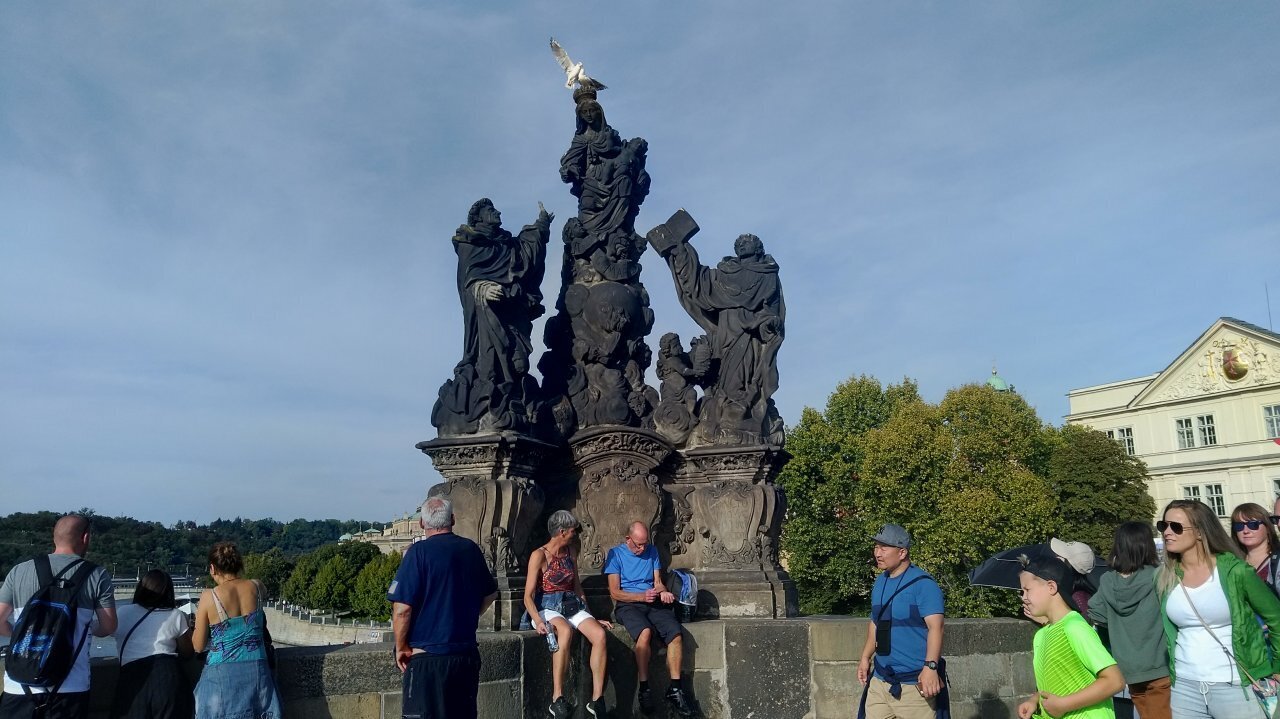
Varvara, Margarita and Elizabeth
Catholics especially venerate these three holy martyrs. Barbara is the protector of miners and miners. Elizabeth is venerated by the sick, the poor, and bakers. Margaret is the patron saint of the harvest and childbirth.
During her lifetime, Barbara secretly changed her religion to Christianity from her pagan father, and for this he beheaded her.
Margaret is always depicted with a dragon. According to legend, she was imprisoned for being a Christian. At night a dragon attacked her and swallowed her, but Margarita crossed herself and the dragon burst. She was then attacked by a demon, but she defeated him too.
And wealthy Elizabeth simply gave money to the poor and sick, and then gave up her property and began to live in poverty.
- Author: Ferdinand Maximilian Brokof.
- Year: 1707.
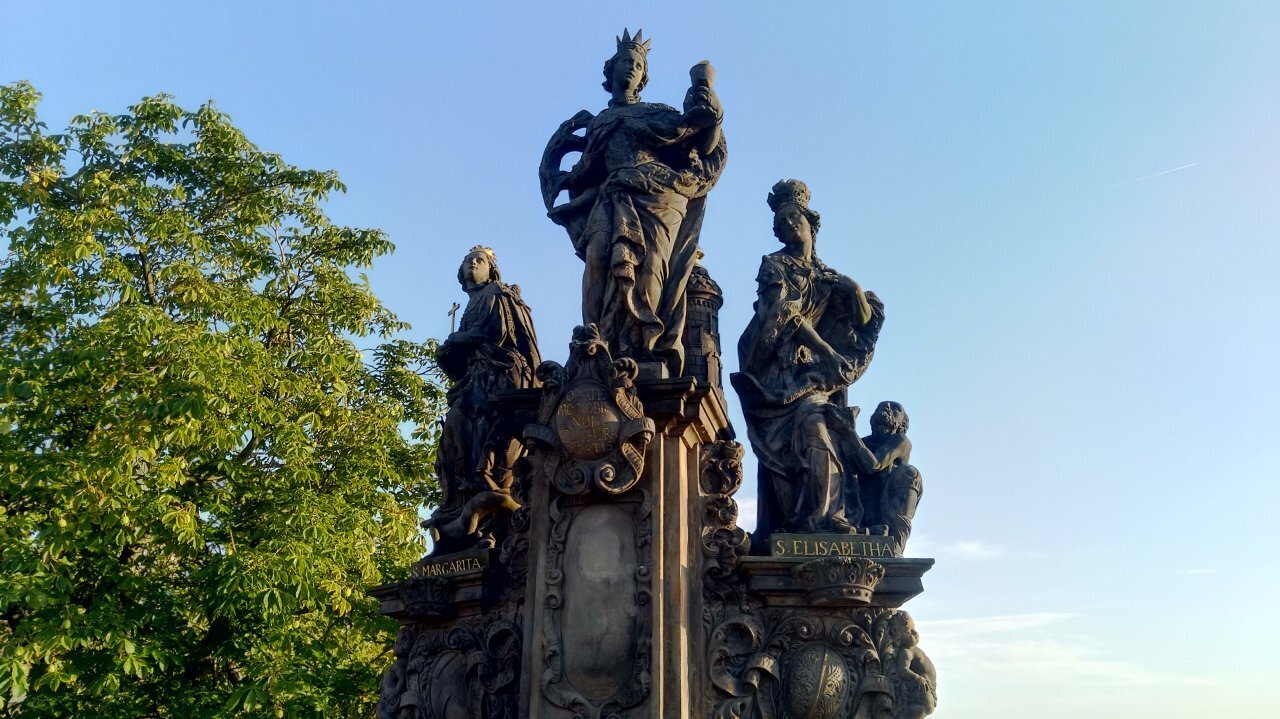
Crucifixion of Christ
This composition has a most unfortunate fate. By order of Queen Elizabeth of Bohemia, the crucifix was thrown into the river because the cross spoiled the view. Later the crucifix was restored, but during the battle a Czech deserter helped the Swedes to shoot the cross from cannons.
To the left of the crucifixion stands the Madonna, to the right John the Theologian. The letters on the cross are finished in gold. It is said that the inscription in Hebrew was made as an admonition — to fine a Jew who passed by the cross and smirked.
- Author: Matej Václav Eckel.
- Year: 1707.
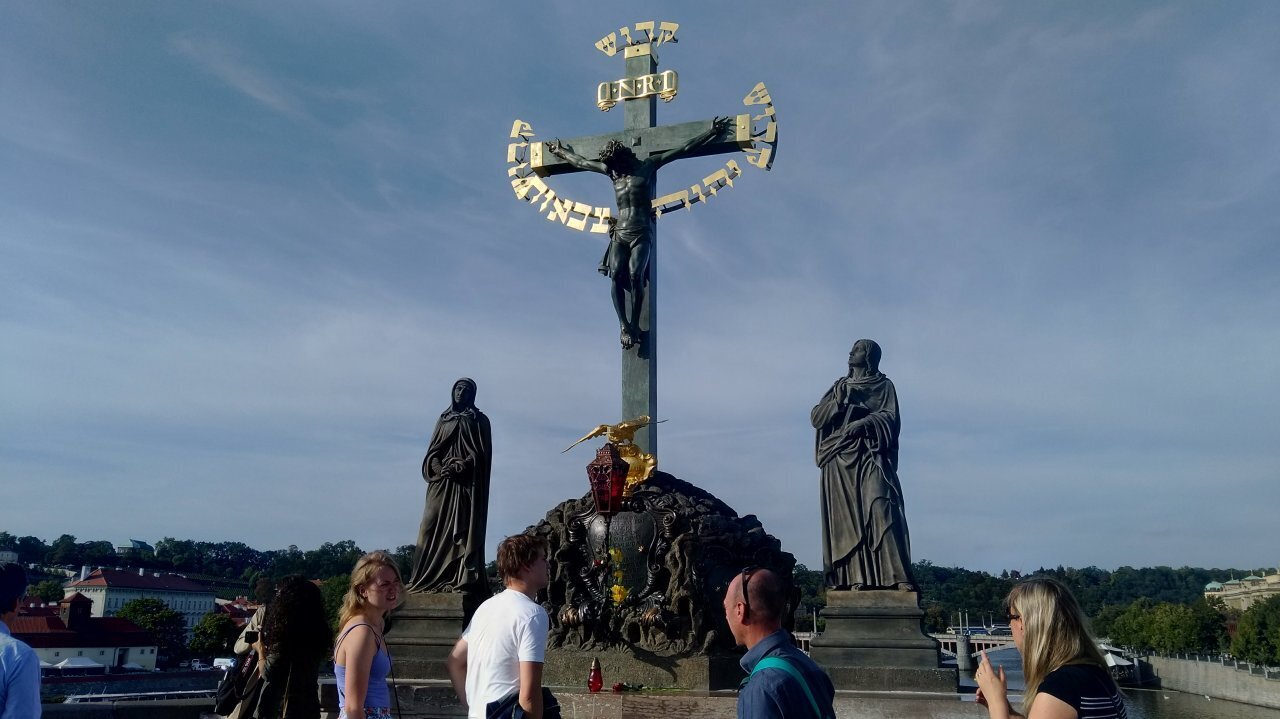
Pieta, The Lamentations of Christ
A touching scene: the Virgin Mary, Mary Magdalene and John the Theologian mourning for Christ. In the past, a cross stood on this spot, and executions were carried out nearby: a person was chained in a cage and immersed in water.
During the flood of 1496, the cross was washed away in the water, and Pieta was erected in its place. In 1848, the new sculpture was damaged — it was shot. The one that stands now appeared 10 years later.
- Author: Emanuel Max.
- Year: 1858.

St. Anne
The grandmother of Christ holds the future Savior in her hands, and her daughter Mary holds out a bouquet of flowers to her. In Catholicism, Anna is the protector of infants, patroness of marriages, orphans and widows.
- Author: Matej Václav Eckel.
- Year: 1707.

St. Joseph and little Jesus
Joseph was the husband of the Virgin Mary, the mother of Jesus. He was a carpenter, so he has a log under his foot, and he is considered the patron saint of lumberjacks, carpenters and woodworkers. In Joseph’s hand is a lily, a symbol of purity.
- Author: Josef Max.
- Year: 1858.

Cyril and Methodius
The story of two monks from Byzantium is familiar to everyone. They gave the Slavic people a written language, so in Christianity they are «Slovenian teachers».
The Czech prince Rostislav invited missionaries from Constantinople to visit him so that his people could learn to read and write with the Glagolitic alphabet. He believed this would help them reach cultural and political heights. The characters at the feet of Cyril and Methodius are Bohemia, Moravia and Silesia: formerly this was the name of the Czech lands.
This is the youngest statue on Charles Bridge. Before it, there was a statue of St. Ignatius, but the sculpture was damaged and moved to the Lapidarium.
- Author: Karel Dvořák.
- Year: 1928.
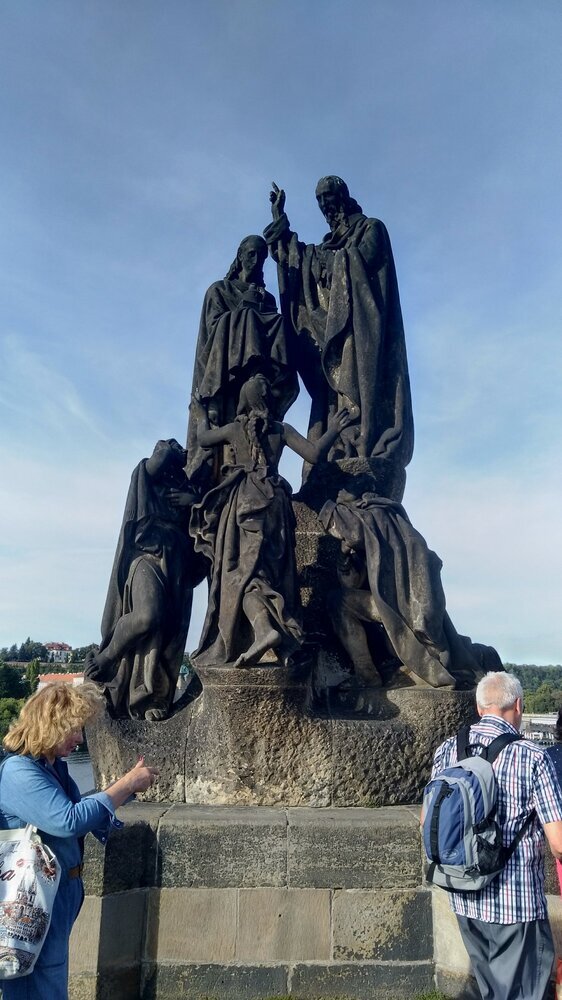
Francis Xavier
If you look closely at the characters around the saint, you may notice Oriental and Indian appearances. Francis, one of the founders of the Jesuit order, preached religion in the east — in India, China and Japan. The pylon is held by a Moor, a Japanese, an Indian and a Turk.
- Author: Ferdinand Maximilian Brokof.
- Year: 1913 copy.
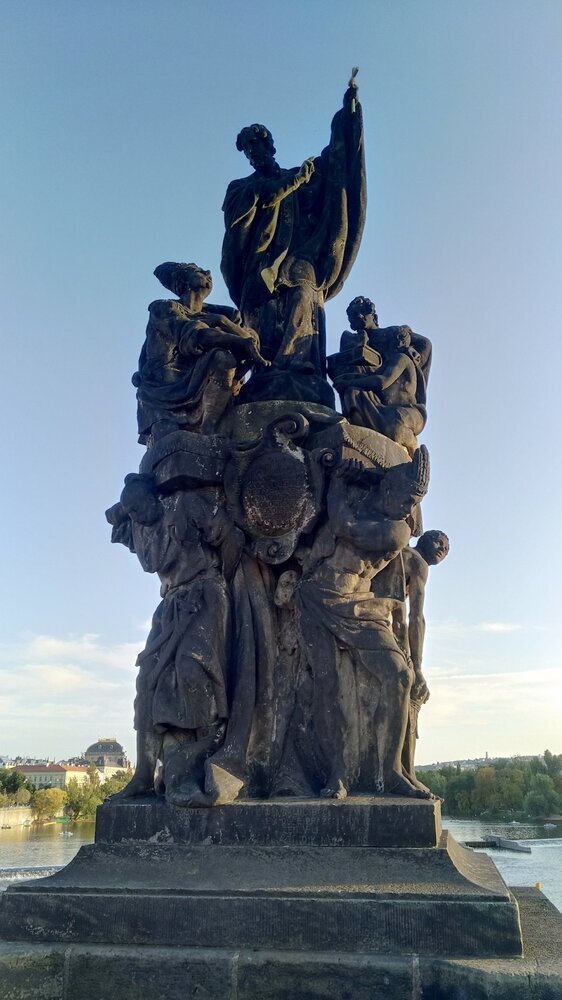
John the Baptist
The historical figure is inextricably linked to the world of Christianity. He foretold the appearance of the messiah, baptized the Jews in the Jordan, including Jesus. In one hand John holds a cup and a cross, and with the other he blesses those passing by.
- Author: Josef Max.
- Year: 1857.
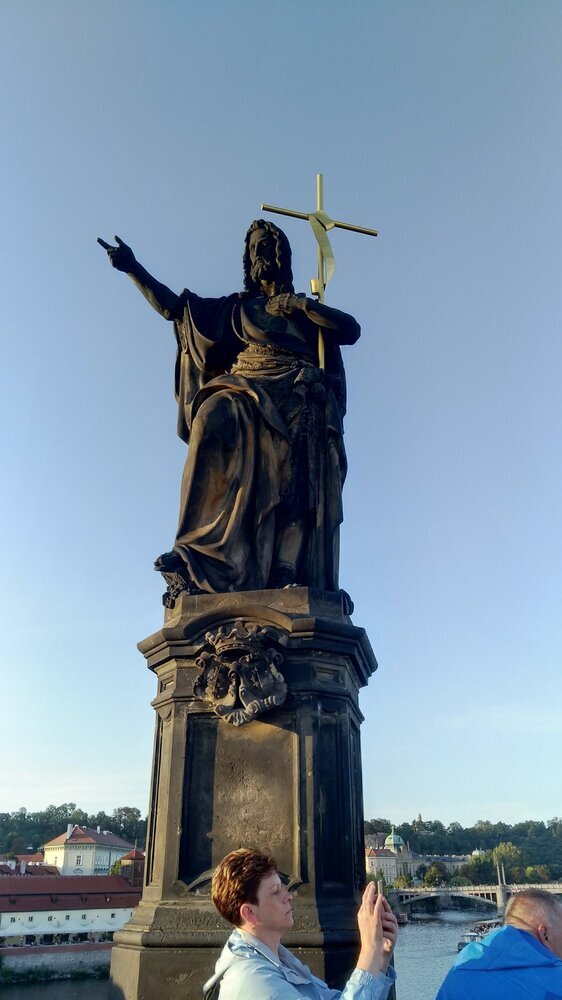
Christopher with the baby Jesus on his shoulders
The Charles Bridge was not always adorned with statues. For example, until 1857, a guardhouse stood in place of Christopher. When the gatehouse was washed away, a sculpture of the patron saint of travelers, seafarers and wanderers was erected in its place. Jesus is on his shoulder and together they are walking across the river.
- Author: Emanuel Max.
- Year: 1857.
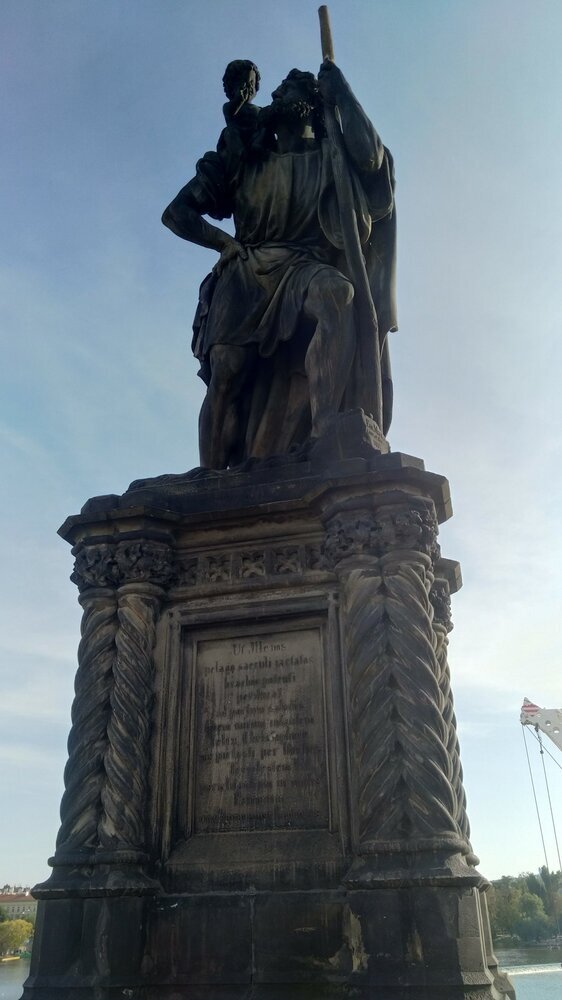
Norbert, Sigismund and Wenceslas.
St. Norbert’s companions changed several times. First they were St. Andrian and St. James, then two angels. In the nineteenth century, King Wenceslas, the patron saint of Bohemia and Prague, and Sigismund, the founder of the Abbey of St. Mauritius d’Agon, remained with him forever.
- Author: Josef Max.
- Year: 1853.
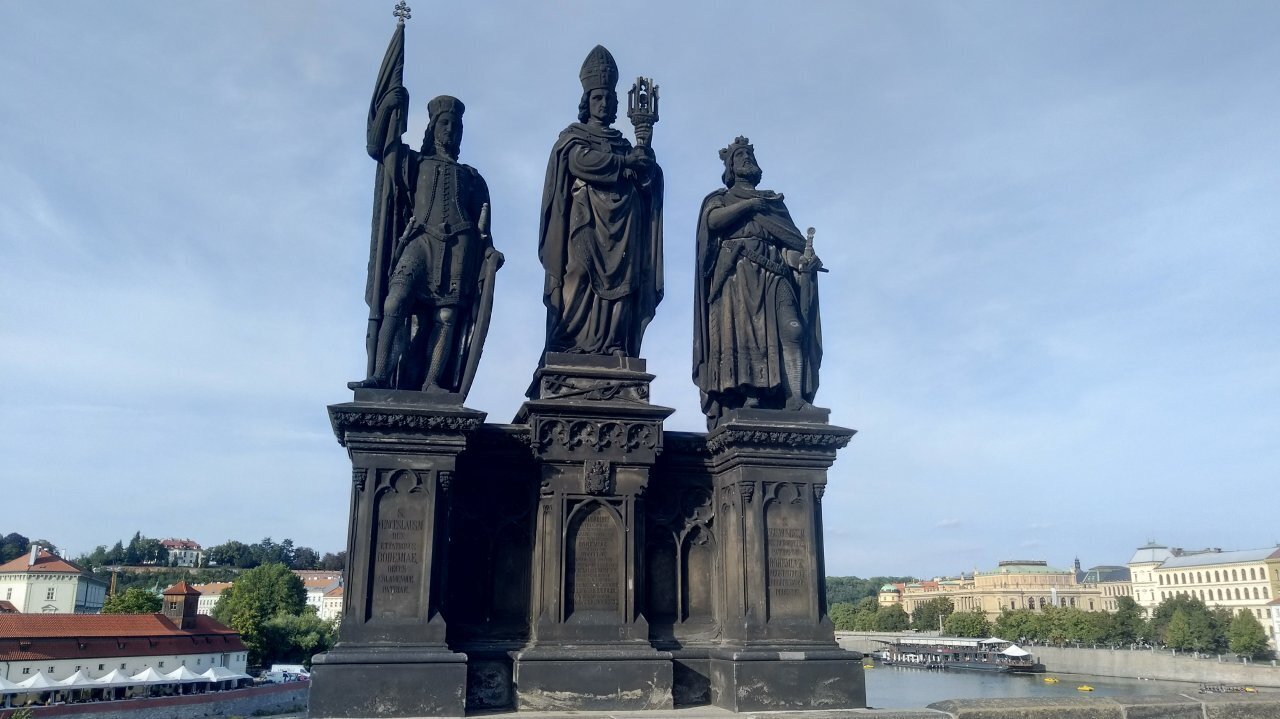
Francisco Borgia
The third general superior of the Jesuit order could have been a duke or viceroy of Catalonia, but he chose the monastic path. He renounced worldly goods and took monastic tonsure. He directed his efforts to spread religion to South America (Mexico and Peru).
- Author: Ferdinand Maximilian Brokof.
- Year: 1710.
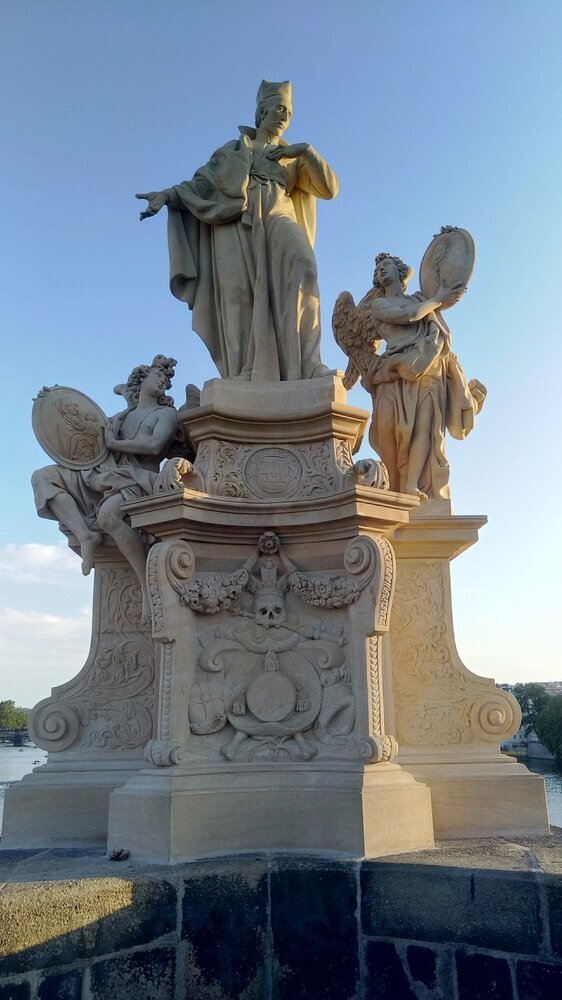
St. Jan of Nepomuk
An important religious figure in the history of Prague and Bohemia. In the 15th century, King Wenceslas IV oppressed the clergy, supported Jan Hus and the Hussite uprising, and emphasized secular power. The ruler crossed the line when he ordered the execution of Jan Nepomucký, the queen’s confessor. The priest, following the rules, did not reveal to the king the secret of the confession of the queen, whom Wenceslas IV suspected of treason.
Jan was sewn into a sack and thrown into the river. At the place where this event took place, you can find a mark in the form of a cross: if you go to Mala Strana, on the right hand is a decorative grate with a bas-relief, under it is a cross. The body was taken out and buried in the Cathedral of St. Vitus, and the king was deposed for an attempt on faith.
- Author: Jan Brokof.
- Year: 1683.
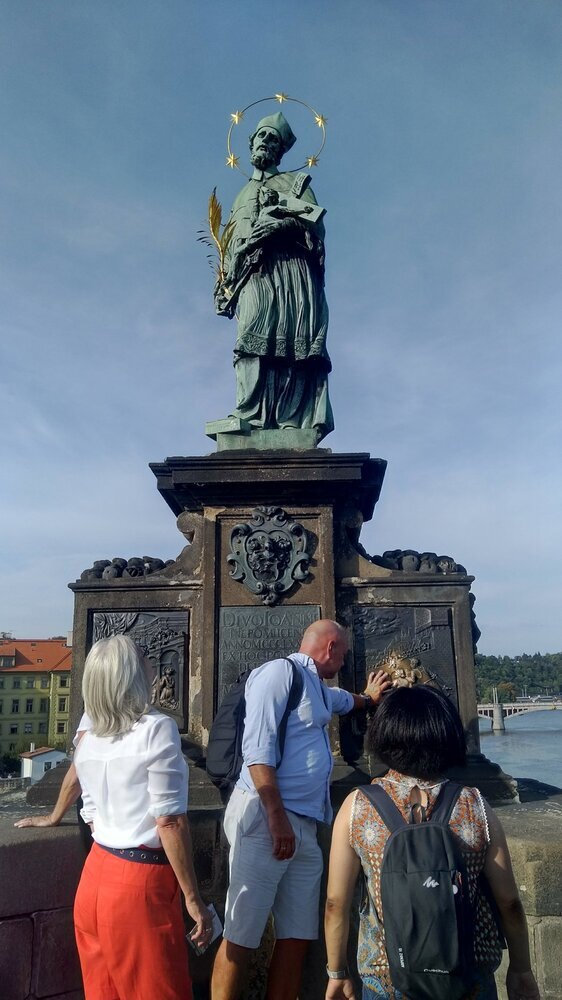
St. Ludmila with little Wenceslas.
Martyr Ludmila of Bohemia is the grandmother of King Wenceslas. This is another Wenceslas: he built St. Vitus Cathedral and zealously spread Christianity in Bohemia. His grandmother, against the wishes of his pagan mother Dragomira, instilled in him a love of her religion from childhood. And her baptizer and mentor was Methodius himself.
Dragomira did not forgive Ludmila for baptizing her son. Several times she tried to destroy her mother-in-law until she left for Techin. But even there the king’s mother did not leave Ludmila alone. She sent two boyars who killed the future saint while she was praying.
- Author: Mathias Bernard Braun.
- Year: 1720.
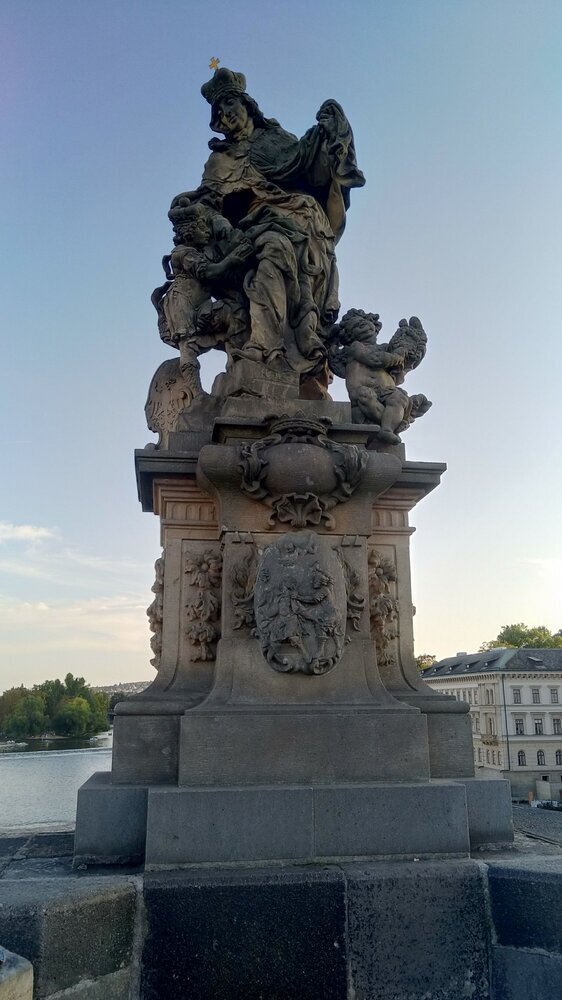
St. Anthony of Padua
Anthony was born in Lisbon, died in Padua, and became popular in Bohemia. The itinerant preacher traveled from town to town, speaking plainly and simply about religion and the meaning of faith. He discovered love in some, and brought others back to religion. He was called a saint during his lifetime.
- Author: Jan Aldrich Meyer.
- Year: 1707.
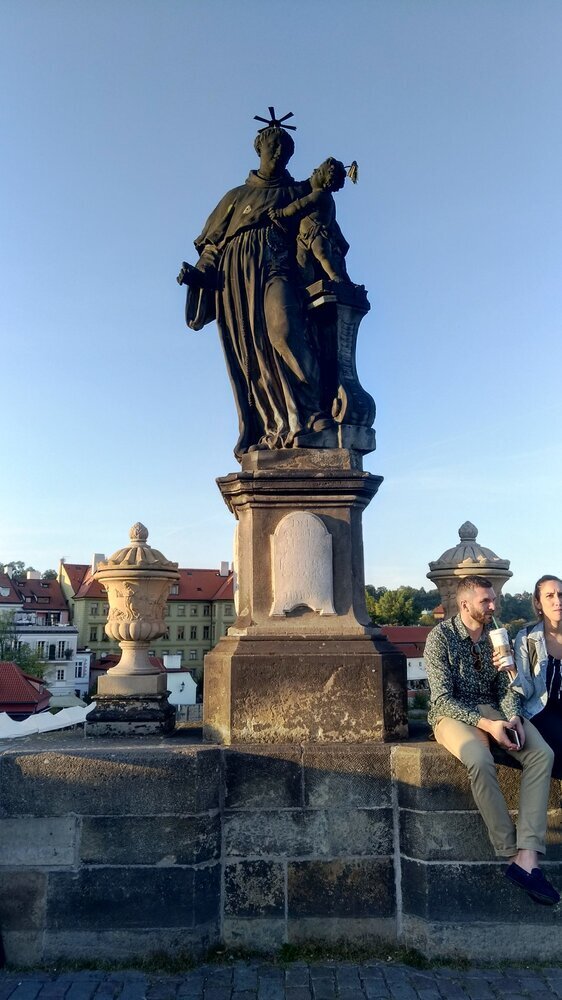
Francis of Assisi
The monk traveled an interesting path before he became the founder of the world-famous order. Francis was born into the family of a wealthy and influential Italian merchant and could have lived without sorrow, but he was drawn to other things. He gave money to the poor and encouraged them to live in poverty. One day he stole goods from his father and sold them, giving all the money away.
Francis went to Pope Innocent III with the idea of founding a mendicant monastic order. At first he was refused, but later he received permission to preach a life of poverty. His ideas were very popular in Europe, and the Franciscans became a very large community.
- Author: Emmanuel Max.
- Year: 1855.
Judas Thaddeus with a club.
Judas of James was one of Christ’s apostles. He was gentle and delicate. But after Judas Iscariot’s betrayal, he was afraid of being mistaken for his namesake, so he changed his name to Thaddeus.
After the death of his teacher, he preached in Mesopotamia, Syria and Greater Armenia, where he was martyred by being beaten with clubs. People believe that he helps those who are in desperate situations.
- Author: Jan Aldrich Meyer.
- Year: 1709.
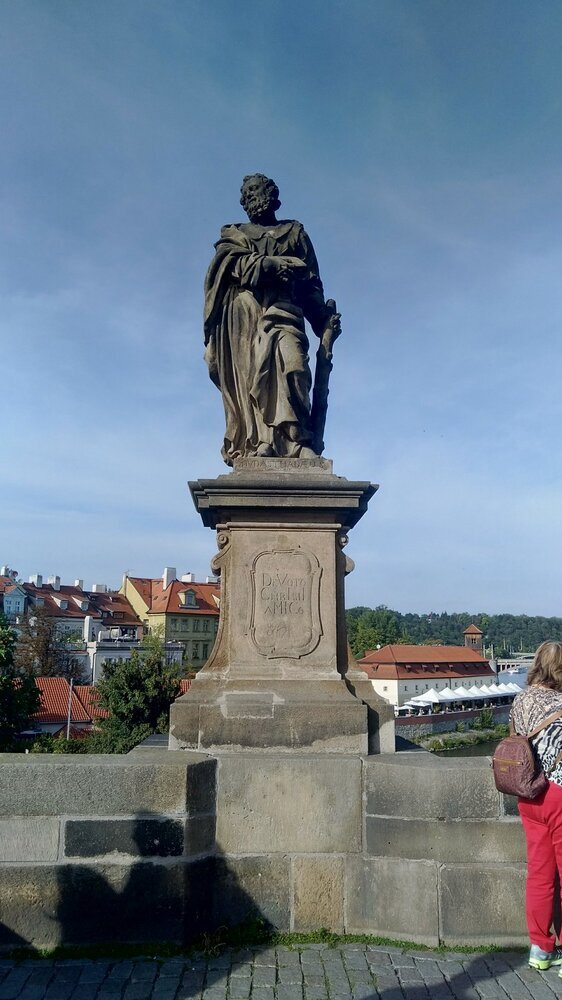
Saints Vincent Ferrer and Procopius of Sazava
The saints on the pedestal trample the demons, and the pedestal is supported by a Turk, a demon, and a Jew.
Vincentius preached Catholicism and was particularly insistent on the Cathars, a Christian heretical sect.
Procopius of Sazava, the founder of the monastery, insisted that services in Bohemia be conducted in the native language. He translated books and services from Greek and Latin, but the idea did not catch on.
- Author: Ferdinand Maximilian Brokof.
- Year: 1712.
Brunswick
The statue stands out from the others. The knight is not connected with religion and stands on a separate pylon. The only thing that unites him and the saints is the defense of Bohemia.
The knight holds a magic sword in his hands. According to legend, if he swings the sword and says «heads off shoulders», it will happen. Brunswick was a hero, his adventures are compared to Homer’s Odyssey. He went in search of a lion for a coat of arms, and when he met the beast, they became friends, then wandered for 7 years, found a sword and returned home.
- Author: Ludwig Schimek.
- Year: 1884.
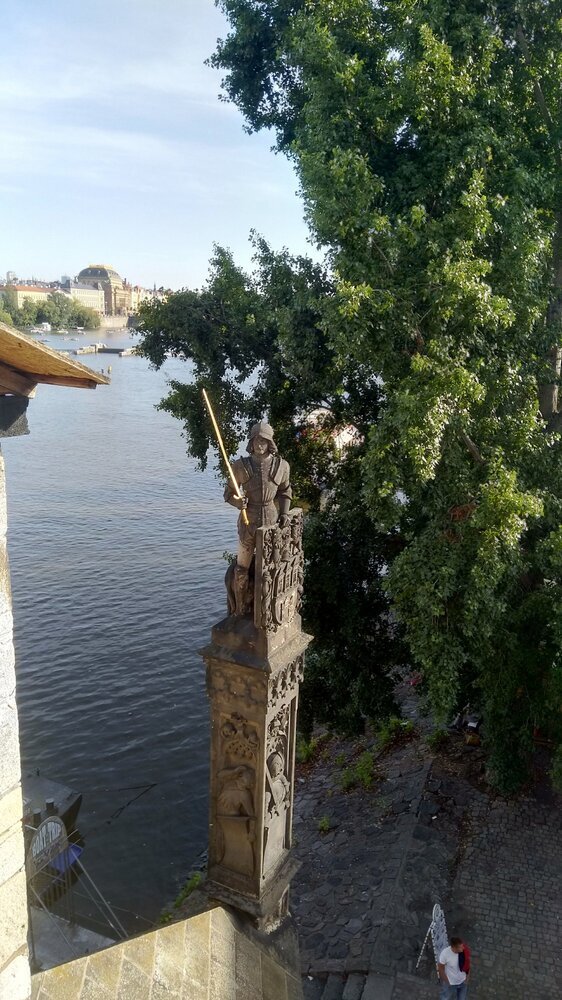

Blessed Augustine
In his youth, St. Augustine was a Manichaean. But later he converted to Catholicism, became a bishop and participated in the destruction of heretical books. The sculptor depicted him in this form — under him are books, including Manichaean books, and they are about to be crushed.
- Author: Jan Kohl.
- Year: 1708.

Nikolay Tolentinsky
The Czech saint holds the bread that, according to legend, saved his life. During Lent, Nicholas became ill, but the Virgin Mary and St. Augustine appeared to him in a dream. They told him how to heal: to draw a cross on the bread, moisten it and eat it. Nicholas prepared and was cured, and then he healed others with this bread.
- Author: Jan Kohl.
- Year: 1708.
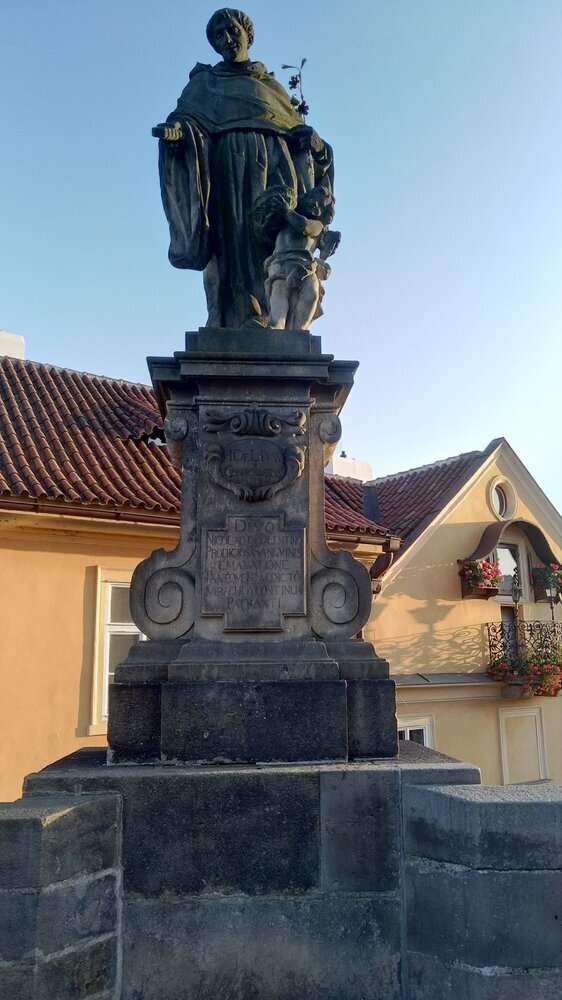
Kaetan
During the plague, St. Kaetan nursed the sick and protected the healthy from the deadly disease. Nearby is a plague pillar as a reminder of those who did not escape death. Similar pillars are found in other European cities.
After the epidemic, he helped the sick, the poor and the hungry, and taught the common people. And now they turn to him if there is a problem with conception or childbirth.
- Author: Ferdinand Maximilian Brokof.
- Year: 1709.
A vision of St. Luitgarde
Luitgarda, a blind nun, said that Christ visited her and they talked for long periods of time. When she was busy helping people, He just waited. One day Jesus appeared in a dream to inform her of his death. But before he did, he let her lay his hands on the stigmas, and this moment is captured in the statue.
- Author: Mathias Bernard Braun.
- Year: 1703.

Philippe Benicius
This sculpture is different from the others. It was made in Austria instead of the Czech Republic, and the material is marble instead of sandstone. And like any marble sculpture, it is much more durable.
Philip traveled extensively, studied medicine, and then decided to stay in Prague. He joined the Servites, the servants of the Virgin Mary.
The Brotherhood was among the mendicant orders like the Augustinians and Franciscans. In 1276, the order was almost closed. Thanks to the efforts of Philip, the group survived and expanded, and a women’s branch appeared. The Servites became known outside the country.
- Author: Michal Bernard Mandel.
- Year: 1714.
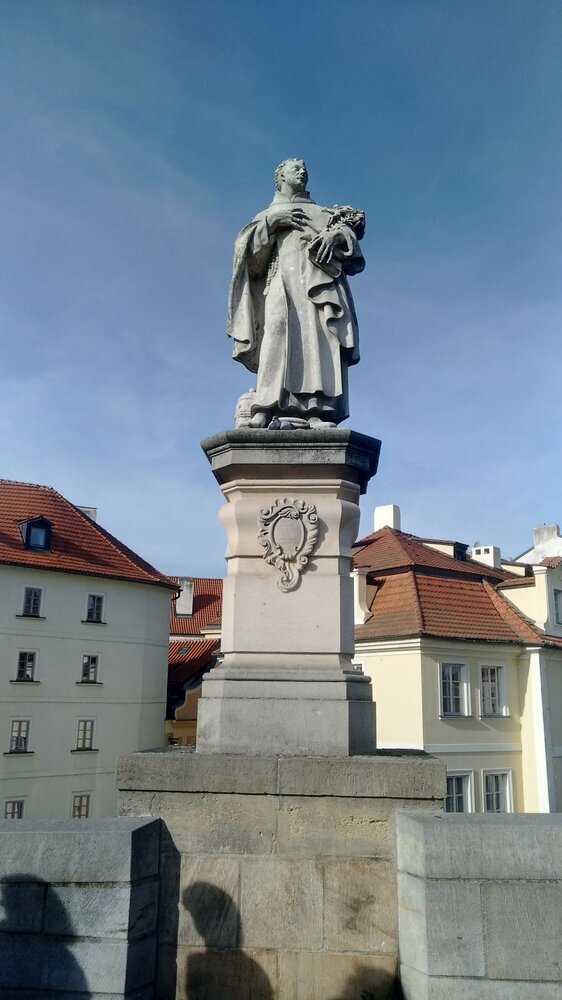
Adalbert of Prague
Adalbert was one of the first baptizers of Prague: he introduced Christianity to the pagans. The citizens of Prague drove him out, and then killed him.
Adalbert’s relics lie in St. Vitus Cathedral — at first the church was even named after both.
- Author: Ferdinand Maximilian Brokof.
- Year: 1709.
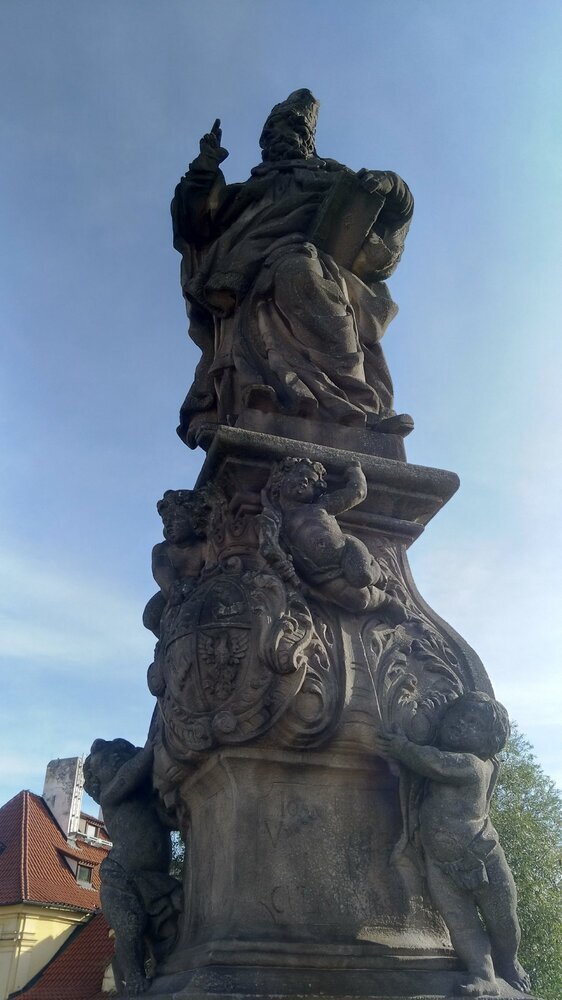
St. Vitus
Prague’s main cathedral is named after this saint from Sicily. He was a Christian from childhood and suffered for it.
The Roman Emperor Diocletian kept the faithful in fear. Vitus refused to join the followers of the pantheon of gods, and for this he was put in a cage of lions. But instead of mauling the saint, the lions licked his feet. Later, Vitus was thrown into a cauldron of oil, where he died. Now the saint is depicted surrounded by lions.
- Author: Ferdinand Maximilian Brokof.
- Year: 1714.
John de Mata, Felix de Valois and John of Bohemia.
In the 7th century, three saints organized the ransom of Christians from the Turks. On the pylon is a cage in which the believers languish, and they are guarded by a Turk and a dog. It is one of the most touching sculptures. The people in the cage look frightening.
- Author: Ferdinand Maximilian Brokof.
- Year: 1714.
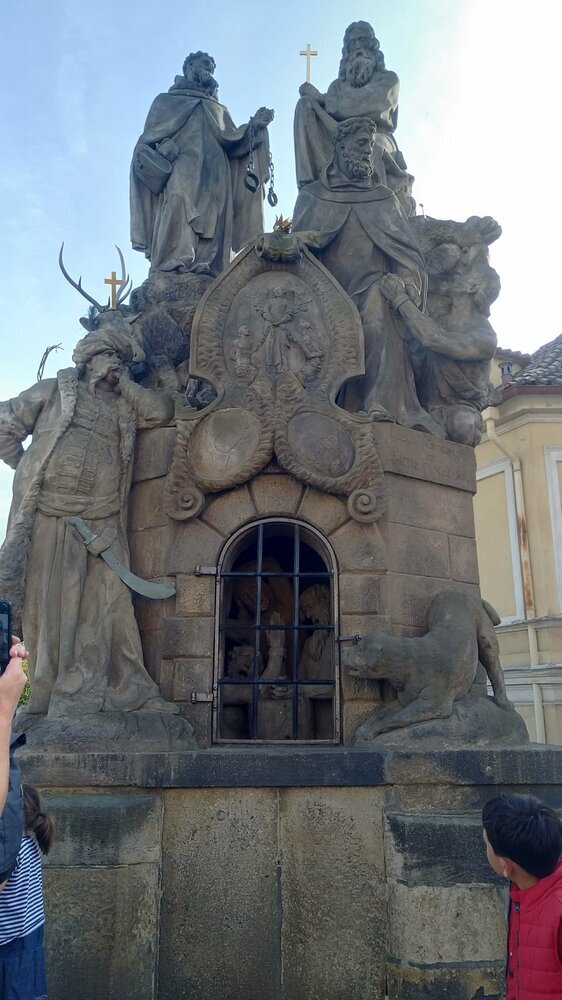
St. Cosmas, Damian and the Savior
Cosmas and Damian were healer-brothers, and in the 3rd century they healed and cast out demons. Rumors about the abilities of the two doctors spread far beyond the city. They helped everyone, but did not take money for it, for which they were nicknamed the spineless.
One theory is that the brothers were twins, which is why both statues look almost identical.
- Author: Jan Aldrich Meyer.
- Year: 1709.
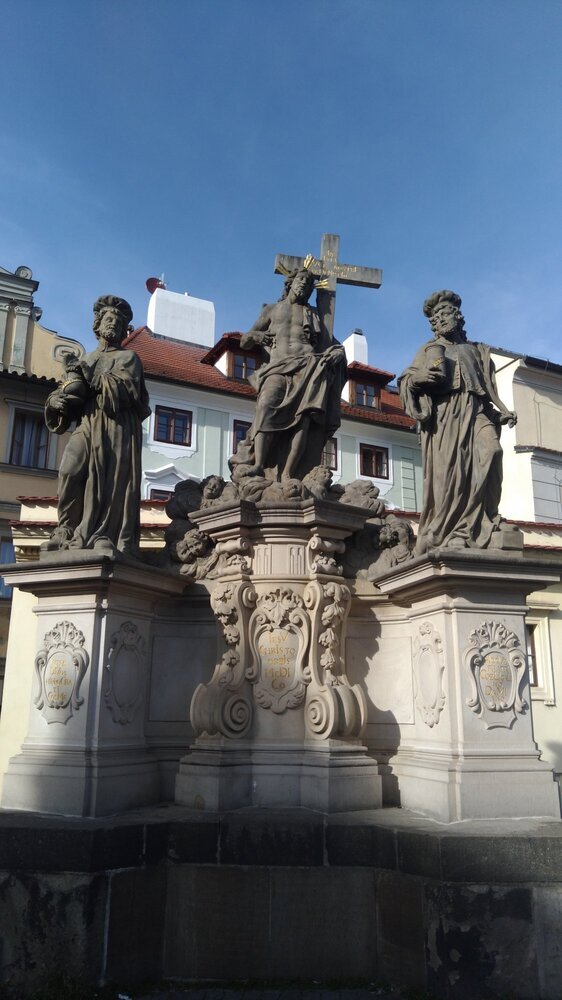
St. Wenceslas
There are three figures of Wenceslas on the bridge, this one is the latest and here he is alone. The stories of the Czech king’s exploits are so popular outside the country that a Christmas song, «A Child’s Christmas in Wales», was dedicated to him. The song was performed by the Beatles, Al Lewis and John Cale.
St. Wenceslas was the first king to baptize his people. He received his knowledge from his grandmother Ludmila, and she was baptized by Methodius. All the sculptures are related to each other.
- Author: Josef Kamil Böhm.
- Year: 1858.
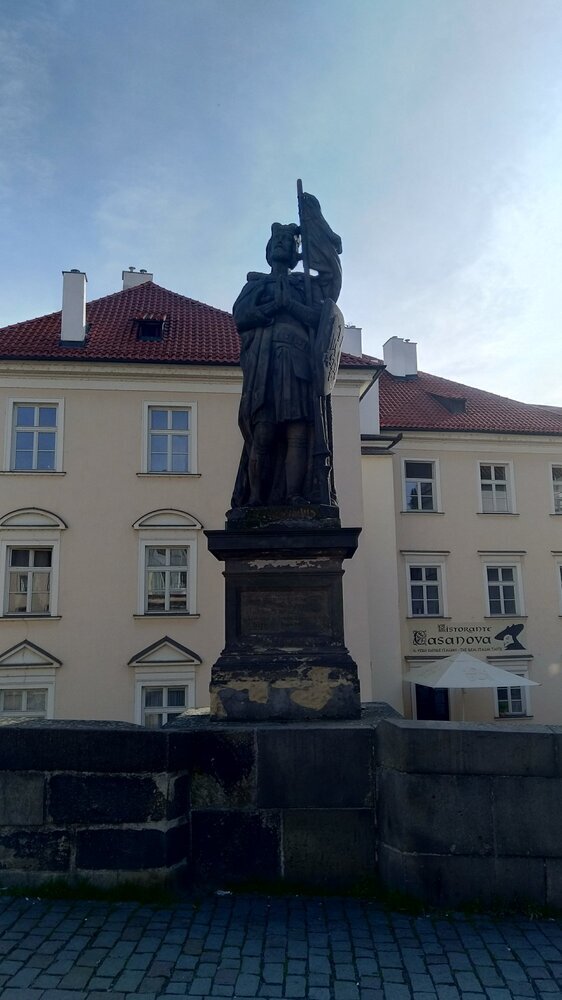
The last figure is the head of the creator of the Charles Bridge, embedded in the base. In the catalog it is marked as «Bearded Man», or Alexander Rodionovich. In the XVII–XIX centuries, the head held an important position — it warned of floods. When the water reached the beard, residents of the coastal streets had to leave their homes.
How do you make a wish?
During rush hour, tourists can be seen taking photos or making wishes by rubbing a part of the sculptures. It is not known who and when this custom was invented and why only some of the 30 statues, not all of them, help dreams come true.
To make a wish on the Charles Bridge, you need a statue of Jan Nepomucký. On the pedestal there are two bas-reliefs with the last moments from the saint’s life, rubbed to a shine. You rub the dog with your left hand and Queen Elizabeth with your right, right after you make a wish.
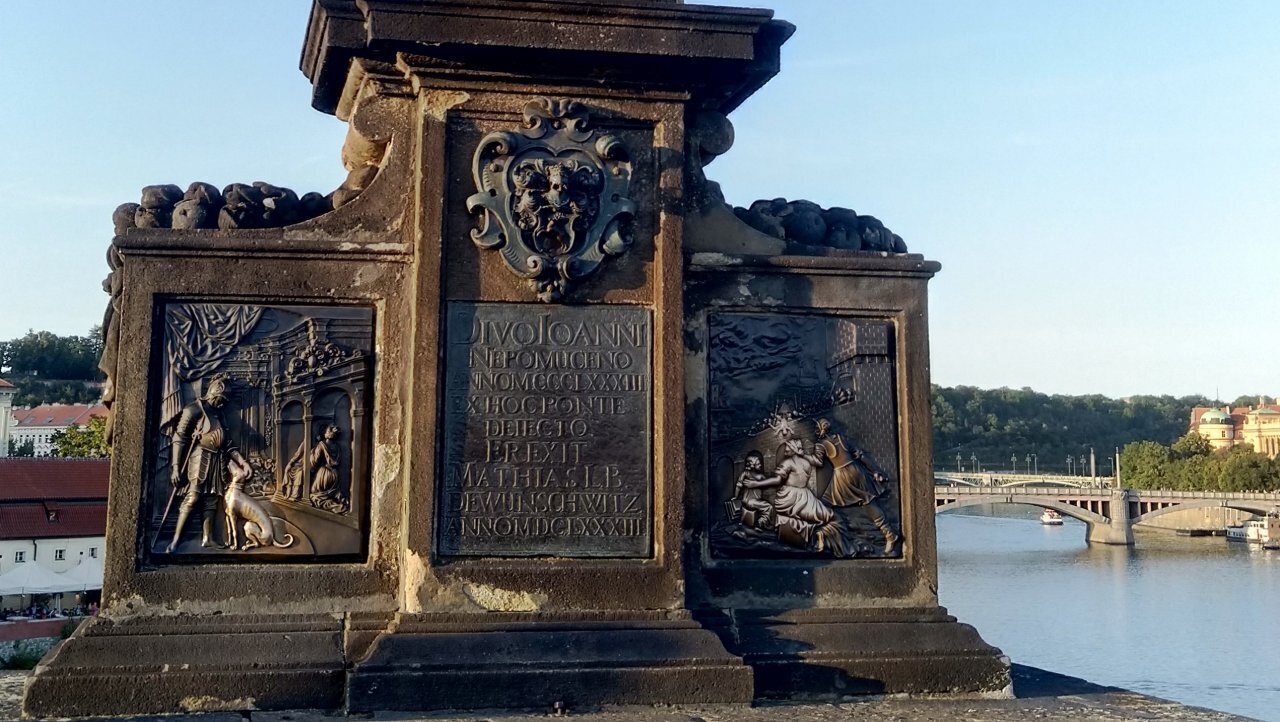
The second way is to find a wrought iron grating with a bas-relief of St. John of Nepomuk. There will be a nail on the bridge. You make a wish, stand on the nail with your right foot, put your right hand on the stars on the saint’s head and your left hand on his feet. It is said that wishes come true within a year.
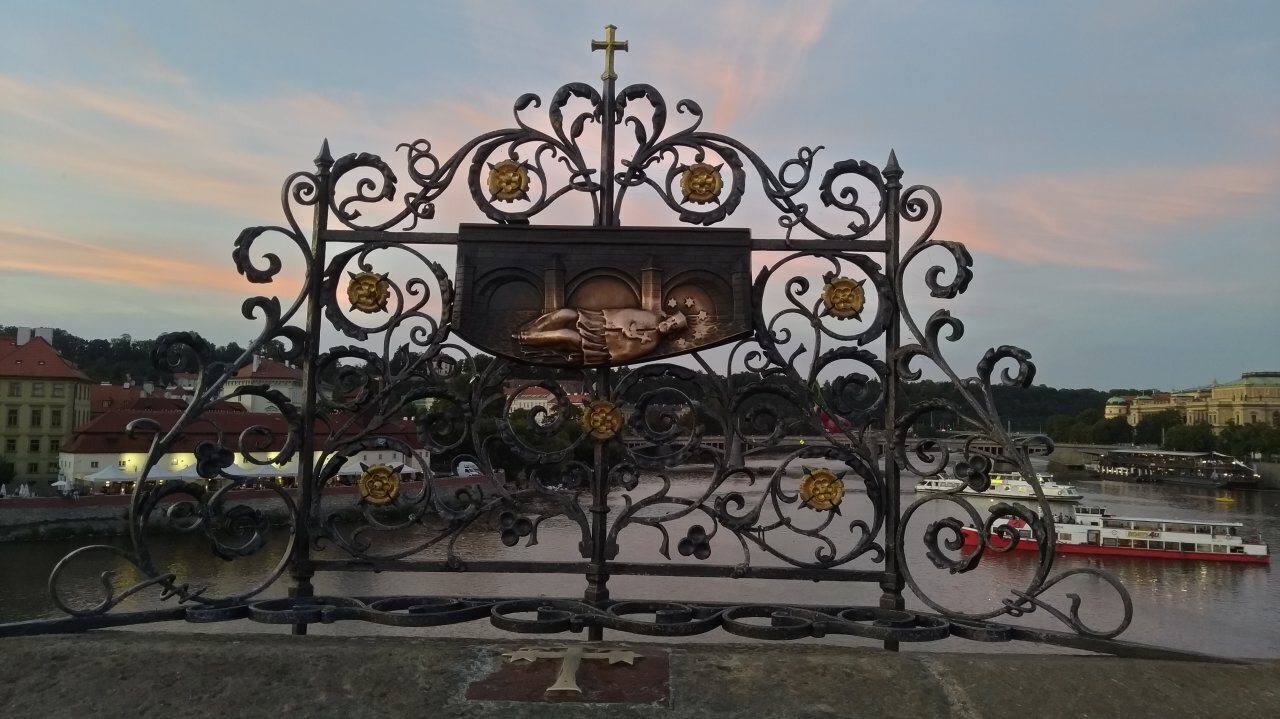
Tips for visiting
- Charles Bridge is always full of tourists and artists. Come for beautiful photos and wishes before lunch.
- There are not two, but three entrances to the bridge. The main ones are from Stare Mesto and Mala Strana, and the third is a staircase on the Kampa Island side. It offers a rather nice view.
- You can view the Charles Bridge from above from one of the towers on either side of the structure. There is a fee.
- The most beautiful photos of Charles Bridge from Kampa Island and Náplavka embankment, where there are a lot of swans. They like to pose for the frame (or decorate the photos).
